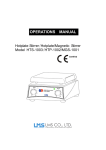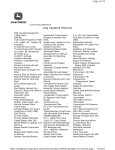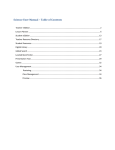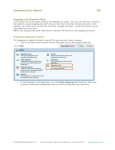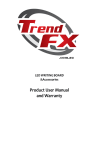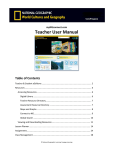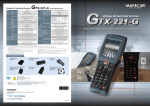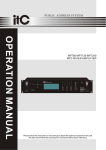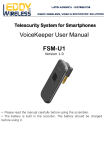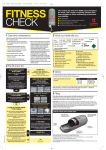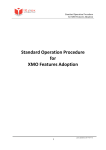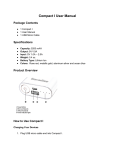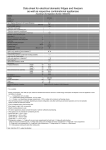Download Fridges and freezers
Transcript
PAS 141 Protocol: Product Guide July 2013 Fridges, freezers and fridge/ freezers The protocol below describes a series of minimum tests that should be performed on fridges, freezers and fridge/freezers in order that the product can be considered functional and fit for re-use. The equipment should pass these tests in order for it to be considered suitable for re-use and the outcome should be recorded for auditing purposes. This protocol should be used within the framework of PAS 141 for re-using electrical equipment. The tests are general in nature so that the protocol can be applied as widely as possible. As a consequence, specific testing procedures and techniques are not described and appropriate equipment should be used to complete the described protocols. Scope This protocol focuses on all domestically used refrigeration units (fridges, freezers and fridge/freezers) for the storage of perishable food and drink items. The original equipment manufacturer’s user manual should be used where available to ensure the equipment functions as originally intended. Test procedure1 In addition to the specific tests, inspection of the electrical and electronic equipment prior to use should be performed to ensure compliance with the law. For example, all equipment should undergo Portable Appliance Testing to ensure electrical safety. Inspection of the cosmetic condition of the equipment should also be performed to ensure that the external casing is not damaged in such a way that could affect the future performance of the product (e.g. a crack in the casing that could lead to degradation of the internal components). 1 Sources include the FRN re-use protocols. Preparation process Visual inspection Components Test Motor and mounting Door hinges and handles Internal freezer door Shelving and salad compartments / bowls Check the motor and mountings are securely in place. Visually check the door. All parts undamaged and mountings secure. All parts are secure and intact. Any internal freezer door should be checked to ensure it closes securely. Check that all shelves (racking & glass) fit properly and are not cracked or undamaged. Door closes securely and is fully operational. All internal components fit correctly. Feet Refrigerant / blowing agent and compressor / motor Safety Plug and lead cables Function test Light Thermostat Check all salad compartments / bowls are present and fit properly and are undamaged Check all four feet Check rating plate for details of gases used and record on report Check matrix at back of unit for signs of damage / leaks. Check compressor / motor for signs of oil leaks. Checking piping intact Examine the plug (insulated) and lead cables. Check internal lamp/light bulb is in working order. Switch on the appliance. Set thermostat(s) to the midway setting. Check that the thermostat is on once the fridge has cooled to the selected temperature. Temperature control Load the fridge to make the compressor work (e.g. fill old plastic bottles with water). Place thermometers in freezer compartment and on top shelf of the fridge compartment. Ensure that the fridge reaches an operating temperature of 0 to 5°C. Ensure that the freezer can cool to the following temperatures (according to the star rating): -18°C for three-star; -12°C for two-star; 6°C for one-star. Test should be run for 12hrs to ensure that all cooling functions are satisfactory and that over-freezing etc does not occur. Appliances with auto-defrost should be set to defrost and run for minimum of 12hrs. Test results Feet are all present and can be rotated to level appliance Rating plate should be present and readable. If any leaks are detected in the matrix or compressors apply epoxy resin and tape and dispose of at appropriately licensed facility. All in good condition, sleeved, with correct fuse, correctly and securely connected. The light works on opening the door. The fridge/freezer cools to the required setting. When the appliance reaches the set temperature, the thermostat interrupts the electricity flow to the compressor, which stops compression. The compressor starts and cooling begins. Correct temperature achieved for both fridge and or freezer compartments. Auto-defrost function in freezer or ice box should perform correctly with all ducts and channels cleared. Preparation process Components Compressor / gas system Test Check that the compressor starts up, and continues running. Check for signs of leaks. If temperature test passes, there is no need to de-gas the appliance and re-gas. An internal leak may be confirmed by applying a vacuum to the system. Check vacuum gauge (a leak can be determined by a rise ) Water / ice dispensing system Door seals After 10 minutes check compressor (cool). Check condenser (warm) Check that water supply is connected to inlet valve on refrigerator and that water flows from the dispenser. Check that ice dispenses from the bucket. Thoroughly check seals / channels and remove any debris / grit. Check carefully for bulges which may indicate foreign objects (knife tips, needles etc) Check all door seals are present and not damaged / cut and are operating properly by putting a lit torch into the fridge or freezer. Close the door and check for any leakage of light through the seals. Cleaning Carcass & seals Test top seal and lower door seal seals by aligning sheet of paper with door The seals, interior and exterior surfaces and shelves and salad compartments / bowls, and internal floor surfaces, shall be cleaned to remove any food residue that could degrade and develop into biohazards. Test results The system does not leak. If any external leaks are detected in the matrix or compressors apply epoxy resin and tape and dispose of at appropriately licensed facility. Any internal leaks may be repaired and the appliance regassed and tested again. Water supply is connected, and water is dispensed at a suitable flow rate. Cubed and crushed (if feature is present) ice should be dispensed. Door seals should be clear of debris and undamaged and intact (with all seals in contact with main carcass). No light should be visible when the door is shut. Paper should remain in situ when door is shut. Cleaning materials such as diluted bleach should be used. Further information and relevant equipment De-gassing and re-gassing should only be performed by qualified cooling engineers (City & Guilds), and will require specialist equipment including cylinders and valves. Thermostats will be needed to check temperature, and a torch to check seals. All former user identification (e.g. asset tags, portable appliance test stickers, company logos etc.) should be removed. Manufacturers brand labels and rating plates should not be removed. If any process fails the unit may require disassembly and / or repair. Identify any hazards, risks and controls before the appliance disassembled to reduce risk. Where replacement components are required to replace a missing or faulty component, such replacements must not impair the product safety. The appliance should then be retested for safety and for function. While we have tried to make sure this guide is accurate, we cannot accept responsibility or be held legally responsible for any loss or damage arising out of or in connection with this information being inaccurate, incomplete or misleading. This material is copyrighted. You can copy it free of charge as long as the material is accurate and not used in a misleading context. You must identify the source of the material and acknowledge our copyright. You must not use material to endorse or suggest we have endorsed a commercial product or service. For more details please see our terms and conditions on our website at www.wrap.org.uk www.wrap.org.uk/eproducts




